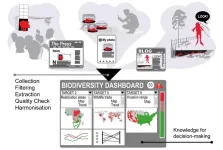Climate change has brought forward the flowering period in Doñana National Park by 22 days
A team at the University of Seville has studied trends in the flowering date of around fifty plant species over the last 35 years in Doñana National Park
2024-02-16
(Press-News.org)
Researchers from the University of Seville have investigated how the flowering of 51 species of shrubs, bushes and trees has changed over the last 35 years in Doñana National Park so as to understand how plant communities are responding to climate change in the south of the Iberian Peninsula. Over this period, the average temperature in the area has increased by 1 °C and the minimum temperature by as much as 2 °C. As a result, the community’s peak flowering time, the time when the greatest number of species are in flower, has been brought forward by 22 days, from 9 May to 17 April.
This earlier flowering is not due to only a few species; rather, 80% of the species have brought forward the onset of flowering, while 68% have brought forward the end of flowering. The most advanced species is rosemary (Salvia rosmarinus), which has been brought forward by 92 days. Moreover, because flowering start and end dates are not being brought forward equally, many species are flowering for longer, leading to combinations of species in flower that did not previously flower together: 55% of species now find an “overcrowded” neighbourhood of flowers, which can lead to increased competition for pollinating insects’ attention.
Flowering is a key moment in the life of plants, since they reproduce sexually through flowers. For a plant to reproduce, it must flower at the same time as its neighbours, and since plants cannot move, they rely upon insects to carry pollen (containing the male gametes) from one flower to another, so the activity of plants and insects must be synchronised.
However, owing to climate change, plants are flowering earlier in the northern hemisphere, as several studies published in Europe, Asia and North America have shown. Added to this problem is the fact that, in the Mediterranean, the impact of climate change is being felt more than in other parts of the world, with temperatures rising 20% faster than the global average.
Plants’ response to climate change in the Doñana environment is among the largest described to date in the world. We know that plants need to “accumulate” hours of warmth to know when to flower, and they are possibly reaching the required amount much earlier. Some species may consequently produce fruit or germinate at less favourable times of the year (exacerbated by drought) or face unexpected competition from pollinators.
This research was possible due to the fact that the flowering of this plant community was studied in the 1980s. The aim of that study was a different one and it could not have been foreseen just how useful this data would prove to be in revealing the effects of climate change on our biodiversity. Studies monitoring natural communities require long-term perspectives, which are often incompatible with the reality of research projects that have to be completed in the short term. In this case, basic research has enhanced our understanding of the magnitude of the effects of a global problem such as climate change on biodiversity and our environment.
END
ELSE PRESS RELEASES FROM THIS DATE:
2024-02-16
A team of researchers are encouraging us to swap textbooks for games, as they drive the application of games in learning, engagement and research.
Known as ‘serious games’, these games are designed for more than just entertainment. Ranging from digital applications to physical board games, they are developed for learning, problem solving, raising awareness, research, and stakeholder engagement – with potential in both schools and workplaces. A key application will be for educating people on sustainable development and climate change.
Experts leading in the field at the Universities of Warwick, Cardiff, York, and Sussex, ...
2024-02-16
Understanding how the poor deal with the effects of the economic crisis into which Brazil plunged in 2014 was the aim of the research project “The crisis seen from the periphery: struggle for social mobility in the frontiers of (i)legality” conducted by Leonardo de Oliveira Fontes with FAPESP’s support (19/13125-2 and 21/13970-4). An article published in the International Journal of Urban and Regional Research is one of the results of the investigation.
Fontes is currently a professor in the Department of Sociology ...
2024-02-16
About The Study: The findings of this study of children and adolescents with acute concussion suggest that moderate-to-vigorous-intensity physical activity reduced symptoms up to a certain threshold but appeared to offer no further benefit in symptom reduction beyond that point.
Authors: Andrée-Anne Ledoux, Ph.D., of the Children’s Hospital of Eastern Ontario Research Institute in Ottawa, Ontario, Canada, is the corresponding author.
To access the embargoed study: Visit our For The Media website at this link https://media.jamanetwork.com/
(doi:10.1001/jamanetworkopen.2023.56458)
Editor’s Note: Please ...
2024-02-16
About The Study: The rebound in the total size of the U.S. registered nurse (RN) workforce during 2022 and 2023 indicates that the earlier drop in RN employment during the first 2 years of the COVID-19 pandemic was likely transitory. Updated forecasts of the future RN workforce are very close to those made before the pandemic.
Authors: David I. Auerbach, Ph.D., of Brandeis University in Waltham, Massachusetts, is the corresponding author.
To access the embargoed study: Visit our For The Media website at this link https://media.jamanetwork.com/
(doi:10.1001/jamahealthforum.2023.5389)
Editor’s Note: Please see the article for additional information, ...
2024-02-16
Delays in diagnosing melanoma due to Covid-19 lockdown may have contributed to over 100,000 years of life lost across Europe and over £6bn in costs, mainly indirectly due to loss of productivity, finds a new study led by UCL and University Hospital of Basel researchers.
The authors of the new JAMA Network Open paper say their findings show how vital early detection of cancer can be, while also highlighting the importance of considering unintended side effects in any future pandemic planning.
Co-lead ...
2024-02-16
About The Study: In adults with mild to moderate hypertension, treatment with zilebesiran, an investigational RNA interference therapeutic, across a range of subcutaneous doses at 3-month or 6-month intervals significantly reduced 24-hour mean ambulatory systolic blood pressure at month three in this phase 2, randomized clinical trial.
Authors: George L. Bakris, M.D., of University of Chicago Medicine, is the corresponding author.
To access the embargoed study: Visit our For The Media website at this link https://media.jamanetwork.com/
(doi:10.1001/jama.2024.0728)
Editor’s ...
2024-02-16
“Previous research has shown that our power system can be transformed to renewable sources like wind and solar at low cost and low environmental impact. However, the next question is how this renewable electricity can be used to substitute fossil fuel use in the buildings, industry and transport sectors. Our analysis shows that the direct use of electricity, for example, via electric cars and heat pumps, is critical for a broad range of sectors, while the conversion of electricity to hydrogen is important only for few applications,” ...
2024-02-16
Researchers have identified a protein that evolved concurrently with the emergence of cellular compartments crucial for the multiplication of the toxoplasmosis pathogen.
Toxoplasmosis is an infectious disease found worldwide, caused by the single-celled parasite Toxoplasma gondii. In humans, infection poses a particular risk to pregnant woman, as it can lead to birth defects. Like the closely related malaria pathogen – Plasmodium falciparum – and other related species, T. gondii possesses special organelles, so-called rhoptries ...
2024-02-16
The random information posted online could be used to generate information about biodiversity and its conservation.
“I think it's quite amazing that images and comments that people post online can be used to infer changes on biodiversity”, says Dr. Andrea Soriano-Redondo, the lead-author of a new article published in the journal Plos Biology and a researcher at the Helsinki Lab of Interdisciplinary Conservation Science at the University of Helsinki.
Scientists from the University of Helsinki together with colleagues from other universities and institutions around the world propose a strategy for integrating online digital data from media platforms to complement ...
2024-02-16
Having a heart attack significantly increases the risk of developing other serious long-term health conditions, a major new study shows.
Researchers at the University of Leeds have analysed more than 145 million records covering every adult patient admitted to hospital over a nine-year period to establish the risk of long-term health outcomes following a heart attack – in the largest study of its kind.
Whilst heart attacks are a serious and life-threatening condition, the British Heart Foundation estimates that nowadays more than seven in 10 people survive them, provided they receive quick and emergency treatment to get the blood flowing to the heart muscle again. Yet ...
LAST 30 PRESS RELEASES:
[Press-News.org] Climate change has brought forward the flowering period in Doñana National Park by 22 days
A team at the University of Seville has studied trends in the flowering date of around fifty plant species over the last 35 years in Doñana National Park

